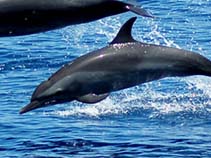Stenella attenuata (Gray, 1846)
Pantropical spotted dolphin| Native range | All suitable habitat | Point map | Year 2050 |

|
| This map was computer-generated and has not yet been reviewed. |
| Stenella attenuata AquaMaps Data sources: GBIF OBIS |
Classification / Names Common names | Synonyms | CoL | ITIS | WoRMS
Mammalia | Cetartiodactyla | Delphinidae
Environment: milieu / climate zone / depth range / distribution range Ecology
Pelagic; oceanodromous (Ref. 75906); depth range 0 - 5300 m (Ref. 116169). Tropical; 22°C - ? (Ref. 75906); 90°N - 90°S, 180°W - 180°E
Distribution Countries | FAO areas | Ecosystems | Occurrences | Introductions
Atlantic Ocean and Indo-Pacific: Stenella attenuata graffmani: Gulf of California and Colombia; Stenella attenuata subspecies A: Hawaii; Stenella attenuata subspecies B: Baja California Sur, Colombia. Tropical to temperate.
Length at first maturity / Size / Weight / Age
Maturity: Lm 182.0 range ? - ? cm Max length : 260 cm TL male/unsexed; (Ref. 1394); 240 cm TL (female); max. published weight: 120.0 kg (Ref. 1394)
Major threats to this species is incidental catches specifically by tuna fishermen in the eastern Pacific, and as sustainable by-catch with the use of gillnets in the Pacific and northern Indian Ocean (Ref. 85211). Spends the majority of their day nearshore, often between 90 to 300 m (Ref. 122680 but they also frequent oceanic waters (Ref. 801). They move further offshore at night into deeper waters to search for prey (Ref. 122680). Feeds largely on epipelagic fish and squid (Ref. 1394). It associates with parasites such as nematodes, cestodes, trematodes and acanthocephalans and commensals that includes cyamids amphipod, and barnacles (Ref. 85211). Social groups are formed by a range of a few individuals to thousands. It is composed of cow-calf pairs, adults and juveniles and they are grouped together or separately by juveniles or breeding groups. Their school size varies within the day (Ref. 85211).
Life cycle and mating behavior Maturity | Reproduction | Spawning | Eggs | Fecundity | Larvae
Main reference
References | Coordinator | Collaborators
Tan, J.M.L. 1995. (Ref. 936)
IUCN Red List Status (Ref. 130435)
Least Concern (LC) ; Date assessed: 05 April 2018
CITES status (Ref. 108899)
Appendix II: International trade monitored
CMS (Ref. 116361)
Appendix II: Migratory species conserved through agreements
Threat to humans
Human uses
Fisheries: commercial
FAO - Fisheries: landings, species profile | FishSource | Sea Around Us
Tools
More information
Internet sources
BHL | BOLD Systems | CISTI | DiscoverLife | FAO(Fisheries: species profile; publication : search) | Fishipedia | GenBank (genome, nucleotide) | GloBI | Gomexsi | Google Books | Google Scholar | Google | PubMed | Tree of Life | Wikipedia (Go, Search) | Zoological Record
Estimates based on models
Preferred temperature
(Ref. 115969): 2.3 - 5.6, mean 3.5 (based on 2741 cells).
Resilience
(Ref. 69278):
Medium, minimum population doubling time 1.4 - 4.4 years (K=0.2-0.37; tm=12).
Price category
(Ref. 80766):
Unknown.



